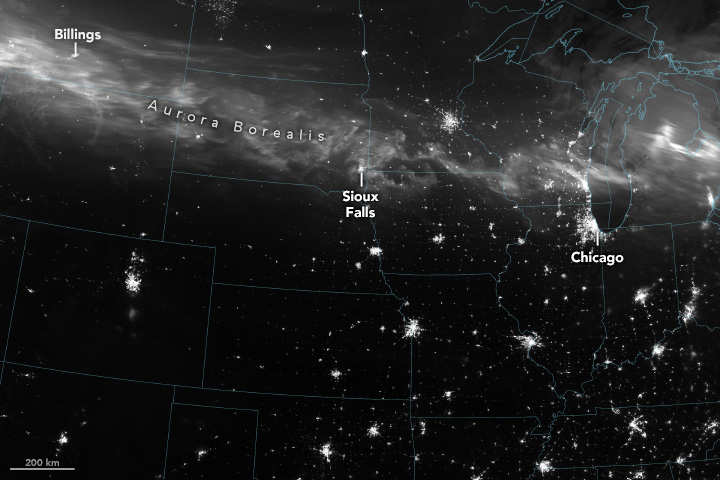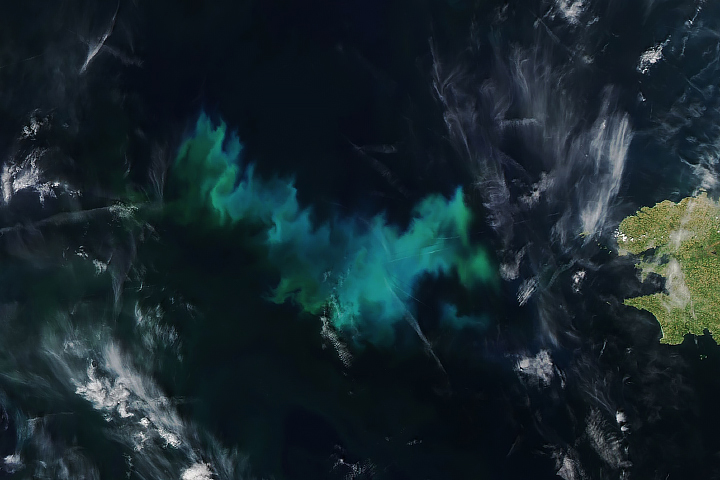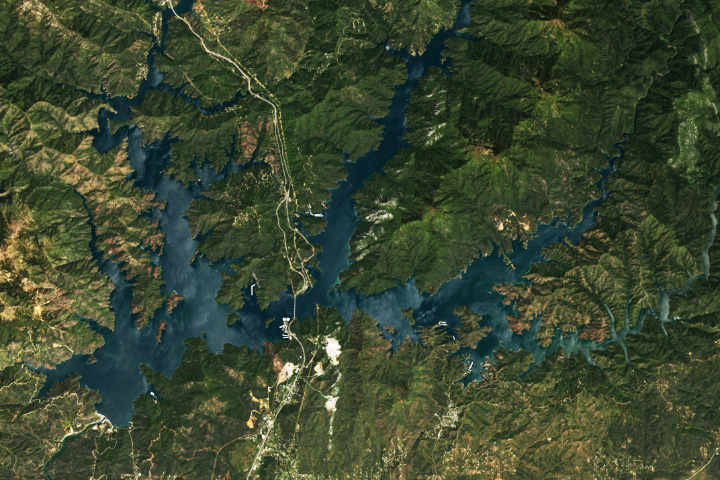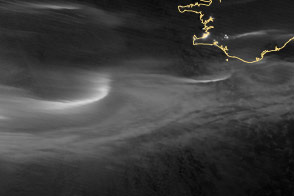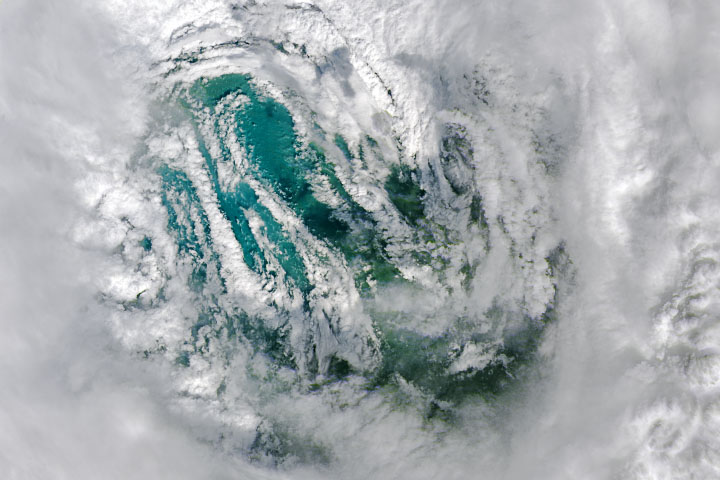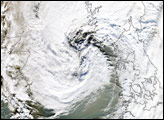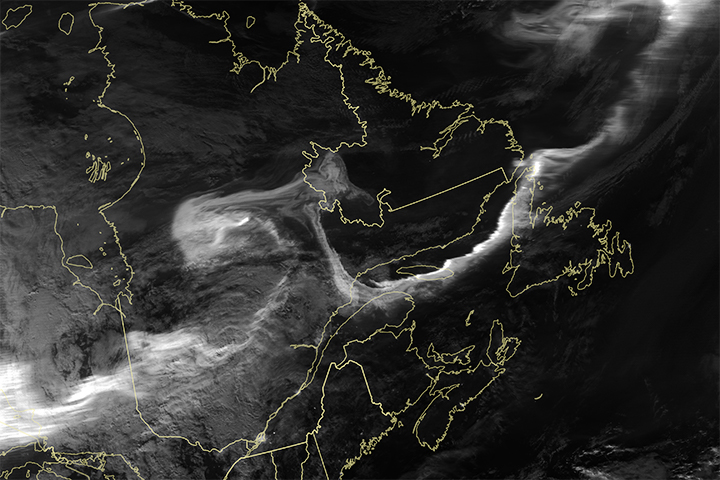

Historic Geomagnetic Storm Dazzles
The strongest geomagnetic storm in over two decades dazzled scientists and sky-watchers alike in May 2024. The G5 storm culminated in a remarkable display of the aurora borealis overnight on May 10–11, visible from many areas worldwide, including latitudes where sightings of auroras are uncommon.
The VIIRS (Visible Infrared Imaging Radiometer Suite) on the Suomi NPP satellite acquired this image of the aurora at 3:20 a.m. Central Time (08:20 Universal Time) on May 11, 2024. The VIIRS day-night band detects nighttime light in a range of wavelengths from green to near-infrared and uses filtering techniques to observe signals such as city lights, reflected moonlight, and auroras.
In this view, the northern lights appear as a bright white strip across parts of Montana, Wyoming, the Dakotas, Minnesota, Wisconsin, Iowa, and Michigan. But auroras are dynamic, and different coverage and patterns of light would have been visible at other times of the night. And while these satellite data are shown in grayscale, viewers on the ground saw colors from green (the most common) to purple to red. Atmospheric compounds found at different altitudes influence an aurora’s color.
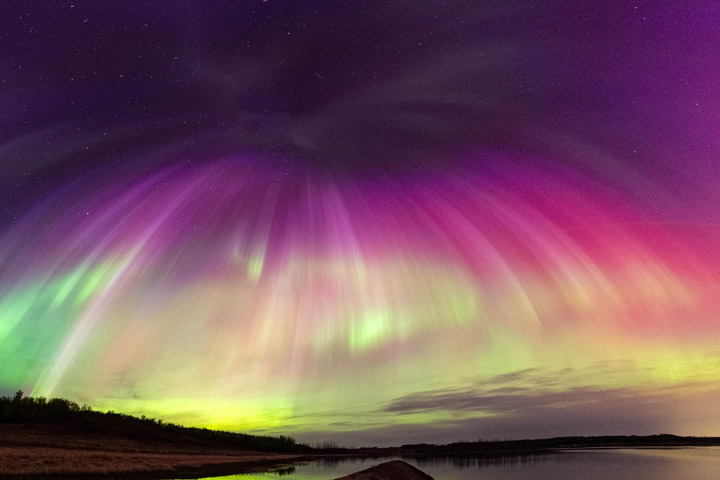
Photographers and aurora chasers captured the striking range of colors in ground-based photos, some of which they shared with NASA’s Aurorasaurus project. The citizen science effort crowdsources eyewitness accounts that scientists can then use to verify, or ground truth, models of where the aurora will be visible from the ground. Auroras occur high in the atmosphere, so observers on the ground can potentially witness them from far away.
Aurorasaurus launched in 2014 around the time of the last solar maximum—the middle of an approximately 11-year cycle when the Sun is most active and produces more sunspots, flares, and coronal mass ejections. Data collected by citizen scientists were highly useful, but the 2014–2015 solar maximum turned out to be relatively “wimpy,” noted Liz MacDonald, a space scientist at NASA’s Goddard Space Flight Center and lead of Aurorasaurus. When auroras did light up the sky, most smart phones could not capture them.
Ten years later, the Sun’s activity has been ramping up again, around the middle of the ongoing solar cycle 25. Photos acquired on May 10–11 show aurora associated with what NOAA called the most extreme geomagnetic storm since 2003. The image above, shot by Aurorasaurus ambassador Gunjan Sinha, shows the sky on May 11, looking south from near Saskatoon in Saskatchewan, Canada.
“This event was really the pinnacle of our vision for the program,” MacDonald said. “Large storms visible this far south are so rare, and we have few chances to study them. Photos from citizen scientists can help us with that.”
NASA Earth Observatory image by Wanmei Liang, using VIIRS day-night band data from the Suomi National Polar-orbiting Partnership. Photo by Gunjan Sinha. Story by Kathryn Hansen.
References & Resources
- Aurorasaurus (2024, May 15) Aurorasaurus map. Accessed May 15, 2024.
- Earth Matters (2023, May 15) Citizen Scientists Capture Brilliant Photos of the Aurora Accessed May 15, 2024.
- EarthSky (2023, March 22) Is a solar flare the same thing as a CME? Accessed May 15, 2024.
- Space Weather Prediction Center (2023, May 15) News Archive. Accessed May 15, 2024.
- The Washington Post (2024, May 10) Severe solar storm could trigger northern lights unusually far south Friday night. Accessed May 15, 2024.


